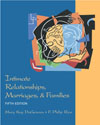Although couples differ in their sexual appetite and habits, sexual expression
is an important part of marriage, with a positive relationship usually found
between occurrence of orgasm and happy marriages. Human physiological sexual
response is similar for females and males, even though the sexual organs are
different. Females tend to be able to have multiple orgasms more easily. There
are a variety of sources of sexual arousal, including tactile, visual, auditory,
verbal, and mental stimulation. Successful sexual relationships for both heterosexuals
and homosexuals can depend on good communication, time and setting, attitude,
satisfaction with frequency of intercourse, and lack of premarital sexual conflicts.
Sexual interest and activity in early adult life are highly related to interest
and activity over time. Males and females have different sexual dysfunctions,
caused by either physical or emotional factors or both. They can be treated
medically, through psychotherapy and marriage counseling or sex therapy. Sexually
transmitted diseases may be caused by viruses, bacteria, or parasites. Individuals
can take certain measures to help protect themselves against the AIDS virus
and other sexually transmitted diseases. |



 2002 McGraw-Hill Higher Education
2002 McGraw-Hill Higher Education